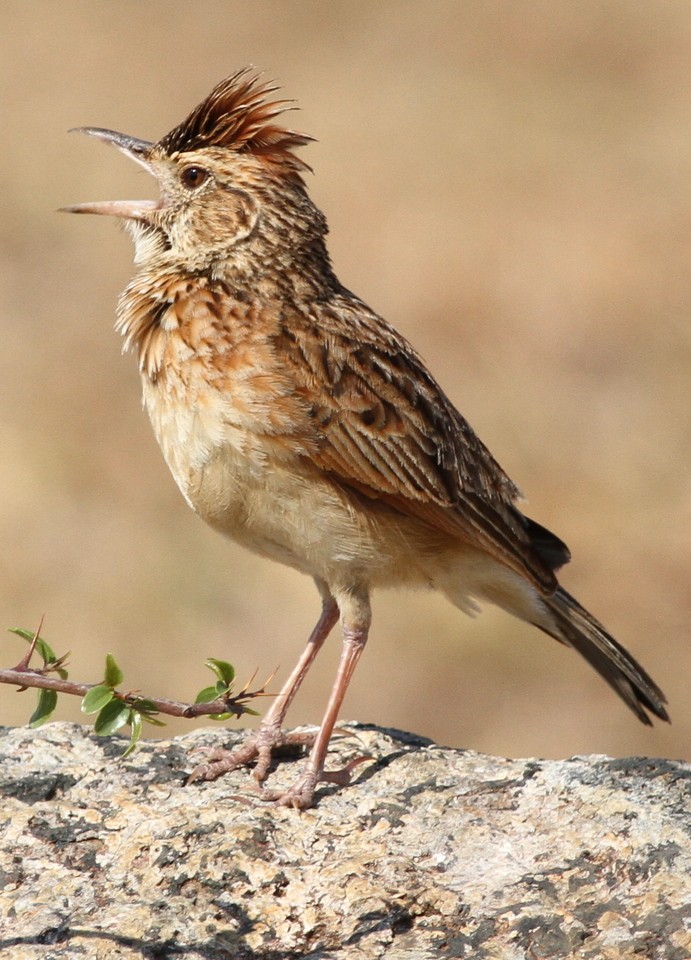Rufous-naped Lark
A species of Bush Larks and Allies Scientific name : Mirafra africana Genus : Bush Larks and Allies
Rufous-naped Lark, A species of Bush Larks and Allies
Botanical name: Mirafra africana
Genus: Bush Larks and Allies
Content
Description General Info
Description
The rufous-naped lark is a fairly large and robust lark species, with rather heavy flight. The sexes are similar, but males average larger and heavier. Adults are individually and geographically variable. It measures 15–18 cm from bill tip to tail tip and weighs 40-44 g. The streaked upper parts, short erectile crest, creamy-buff eyebrow that merges with the lore, and the rufous flight feathers are easily discernible features. The hindcrown and nape are streaked along the feather centers while the margins vary from chestnut, rufous or pinkish buff to greyish brown. The wings appear conspicuously rufous in flight, while the outer edges of the primaries show up as a rufous panel on the closed wing. The underwing coverts are rufous, and upper coverts are broadly edged tawny or buff (or grey in race grisescens). The tail is dark brown, but the outer webs of the outer tail feathers vary from buff (cf. africana and sharpii) to tawny or bright rufous. The mantle is lighter brown than the back, and the rump still darker brown. The flanks are a shade darker than the rufous-buff belly, but regionally the plumage may also be stained red by soil. The throat is unmarked but the pale rufous upper breast is streaked and spotted darker brown. The eyes are hazel brown, the longish bill is blackish and pinkish, and the feet pink to pinkish brown. Juveniles have bold black spotting on the crown, mantle and wing coverts, all edged with buff, while the breast spotting is more blotchy or diffuse. 
Size
20 cm
Colors
Brown
Black
Gray
White
Nest Placement
Ground
Feeding Habits
Rufous-naped Lark forages on the ground for insects, spiders, and other invertebrates, also catching termite alates mid-air. It searches among grass tufts, bare lands, and even explores after fires. Winter diet includes grass and forb seeds.
Habitat
The rufous-naped Lark occupies diverse habitats across sub-Saharan Africa, primarily favoring bushy grassland and sparsely wooded savanna terrains. Adaptable to elevations from sea level to 3,000 meters, these birds thrive in areas with a blend of tall and short grasses. Open landscapes with bare patches, used for display, and edges where woodlands border grasslands, are ideal. Their ecological tolerance encompasses grassy fynbos and karoo, as well as highland sourveld.
Dite type
Insectivorous
General Info
Feeding Habits
Bird food type
Behavior
The rufous-naped lark is sedentary, territorial and monogamous. It is often sluggish, allowing a close approach. Short distances are covered in low, level or undulating flight, or it may flee an intruder by running and dodging through grass haphazardly. It may be difficult to flush from grass, and is easily overlooked when not singing. At any time of the year, but especially when the rains commence, a male will spend hours calling from a conspicuous perch. A clear, somewhat variable, whistled phrase of three to five syllables is typical, which may be rendered as tseep-tseeoo, teeoo-teewee or chiwiki-chiwi. The song may be changed after each 20 or so repetitions. During some intermissions the wings are audibly fluttered in the few seconds between phrases. This results in a quick prrrrt or phrrrp rattle, and may lift the bird off its perch. The crest is also lifted during display. It may alternatively sing a rudimentary song consisting of whistles, tweets and trills (distinguishable as imitated calls), during short flights over the grass or during an upward spiraling flight, before it planes down. Race malbranti in particular, may sing during a straight and direct display flight and clap its wings above its back. Perched males may also string together fragments of the songs of various grassland birds. It utters peewit, tweekiree or pree, pree notes in alarm. 
Distribution Area
The rufous-naped lark is found in many parts of sub-Saharan Africa. It has a very large but discontinuous range, with an estimated global extent of occurrence of 5,600,000 km. Its range is believed to be increasingly fragmented in the north, from which a declining population is inferred. The southern African population has not contracted in range or abundance, save for areas of extensive cultivation or urbanization. Livestock ranching is believed to have created bare patches in grasslands, which they favour. The populations of southern Mozambique and Swaziland have been estimated at >50,000 and 100,000 individuals respectively. It tolerates a range of dry or mesic habitats, typically bushy grassland or sparsely wooded savannah. It also occurs along the fringes of marshes, in woodland clearings or in the fragmented ecotone of woodland and grassland. It is present from near sea level in the south, to about 3,000 meters near the equator. In Zimbabwe it occurs from 900 to 1,800 meters, and in East Africa from 1,000 to 3,000 meters. Termitaria, bushes, small trees or fence posts provide perches for display, while a combination of tall and short grass provides cover and foraging space. In southern Africa it occurs only sparsely in grassy fynbos, grassy karoo and upland sour grasslands, but has high reporting rates in the Eastern Highlands of Zimbabwe, in miombo and in sweet or mixed grasslands. 
Species Status
Not globally threatened.
Scientific Classification
Phylum
Chordates Class
Birds Order
Perching birds Family
Larks Genus
Bush Larks and Allies Species
Rufous-naped Lark 